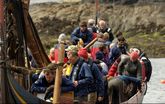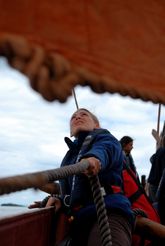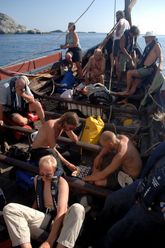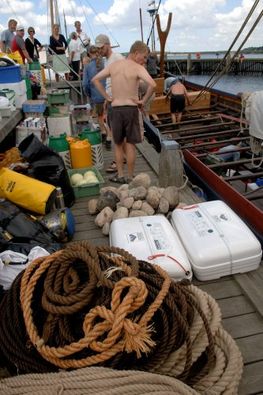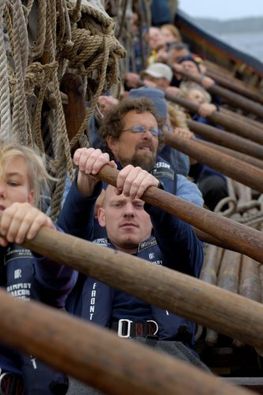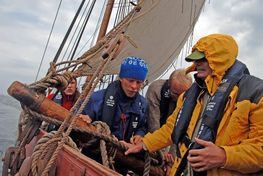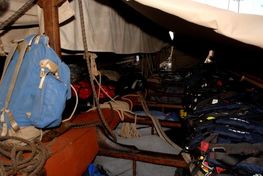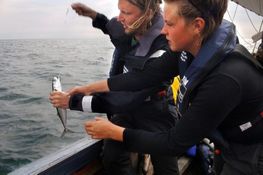Crew
The crew on board the Sea Stallion of Glendalough are referred to as gaster, and they have all volunteered for the project. Nobody has – as in Viking times – been forced to make the voyage, but everybody has been assessed and selected by the ship's skipper and a core group comprising the leaders of the rooms (sections) and the coxswains.
The ship is organised into six rooms, each delimited by the thwarts (benches) on which the oarsmen sit. Each section has a leader, who makes sure the crew carry out their tasks, observe their watches and report to the skipper. The crew have fixed positions in the room so that everybody knows where to stow their gear and which tasks they must perform.
Crew's watches
Just like the Vikings, the crew now form watches. These are referred to as port and starboard watch, respectively, according to the two sides of the ship. Half of the ship's crew are on watch at one time, while the other half can rest and sleep. A watch lasts four hours and must be manned day and night. However, the watch around suppertime lasts only two hours so that everybody has the chance to eat a hot meal.
The crew on board the Sea Stallion do not have to look out for enemy ships – apart from that the ship is organised as in the Viking Age. There are also watches by the sail, the rudder and on lookout. When the ship is in port and the crew goes ashore the Sea Stallion also has an anchor watch keeping an eye on the moorings and the ship. On board the Sea Stallion the position of helmsman, the person responsible for steering the ship, is divided between a small number of people with navigation skills from the lofting - the section of the ship with the skipper and coxswains. The helmsman also changes every four hours.
As the Sea Stallion is 30 m long, a mellemråber (a middleman) is placed by the mast at the centre of the ship so that skipper and coxswains can contact with bow sections of the ship. The middleman’s tasks involve relaying commands and messages on towards the bow of the vessel as well as shouting the look-out’s messages back to the lofting.
In addition to their ordinary watches, the men must also serve kabystjans and bakstørn. When serving kabystjans the watch helps with cooking and when serving bakstørn he washes up after the meal.
Female crew
Even though women were rarely found on board warships in the Viking Age, there are 18 female gaster on the Sea Stallion, and they have no special privileges. Like the men they form part of the watches, and they are also expected to be able to sail the ship, bail out water, row and manage strenuous, physical tasks as well as the rough weather conditions at sea. On the summer expedition to Norway in 2006 it was, however, the female crew members who were the most badly affected by seasickness..!
Personal gear
The crew's personal gear will not be stored in ship’s chests but will be stowed in waterproof sacks holding equipment such as modern waterproof clothes, woollen underwear, warm sweaters, a headlamp, a knife, items for personal hygiene, a sleeping bag and underlay etc.
Conditions for sleeping on board are similar to those in the Viking Age. The crew sleep between the thwarts on the deck or on the oars, which are stowed when not in use. The sleeping bag and mat are only used when going ashore. When the ship is underway, the men sleep wrapped in woollen blankets for safety reasons. In the case of an emergency it can be too dangerous for the men to be inside sleeping bags, which they are not able to get out of quickly. They also have to be able to go on watch quickly without having to clear up a lot of equipment.
Life on board
The watch system on board the Sea Stallion means that the crew is off duty every four hours. Many use their free time for sleep in order to be fit for the night watches. With a crew of 62 it can be difficult to find rest and privacy and many choose to sit down with a book or some music in their ears to feel alone for a while. Some write a diary and take notes.
Games are also played on the Sea Stallion. Many have brought cards and magnetic chess games. The ship also has a songbook with sea shanties and a guitar for festive occasions.
The crew is made up from ten different nationalities and the crew does not meet all that often. Hence the free time is also used to socialise and chat. The crew get to know each other better and pay visits to the other rooms of the ship.
Often, however, it is not possible to have the entire shift off. There are always things that need doing on board, and many crew members use their time off to mend the sail and cordage.
By: Louise Kæmpe Henriksen
